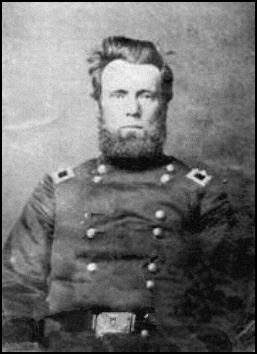Harry Townsend's Hat and the Wild Retreat at Chickamauga
At the Battle of Chickamauga, Second Lieutenant Homer Henry “Harry” Townsend was a newly minted second lieutenant serving on the staff of Brigadier General Samuel Beatty. Townsend held his commission as a second lieutenant in Co. I of the 9th Kentucky Infantry, but had arrived there through an unusual path having spent two years as a sergeant in Co. C of the 19th Ohio before being discharged in August 1863 to accept this promotion. Writing to his mother from Chattanooga ten days after the battle, Lieutenant Townsend relates how Beatty’s brigade went to pieces when Longstreet’s attack struck the Federal line on September 20, 1863.
 |
| Second Lieutenant Homer Henry "Harry" Townsend Co. C, 19th Ohio and Co. I, 9th Kentucky (Library of Congress) |
Saturday night after the first day’s
battle here, when we were standing tired, hungry, thirsty, and half-frozen
around our little fire before retiring for the night, I well remember my friend
George’s remark: “Well, Harry, we are all of us alive, yet.” All I could reply
was “God only knows what the morrow may bring forth.” It brought death to many
a noble soldier.
Did I tell you I lost my hat on the field?
We had our brigade in two lines for support of troops in our front; we had
advanced pretty close to the front and were engaging the enemy hotly; our men
were ordered to lie down to protect them as much as possible. At this juncture,
the General sent me to order the rear line of reserve to fall back and take
double the distance. The fire was growing furious and I saw no time was to be
lost and hurried as rapidly as possible to Colonel [Alexander M.] Stout of the
17th Kentucky regiment. Whilst on my way, my hat was knocked off by
a bayonet, but it would not do to stay there. Colonel Stout ordered his men to
rise and instead of giving the order “backward march,” as he should have done,
he ordered “about face, forward, march.”
 |
Colonel Alexander M. Stout 17th Kentucky Volunteer Infantry (Courtesy Stan Hutson) |
At this critical moment, the fire had become terrible and both front lines which we were to support broke through us en masse, followed by a battery all in precipitous retreat. Our front line was swept back by main force and the rear line, supposing the order “about face” was for retreat, followed in the tide. As soon as I saw Colonel Stout “about face” his battalion, I was fearful of the result, but it was utterly impossible to make him hear. Rushing on immediately came legions of rascally graybacks and such a volley as they poured into us was terrible. The bullets seemed to come in sheets.
We were forced back across an open cornfield to the crest of a hill where several batteries were stationed and belching a perfect avalanche of iron over our heads into the Rebel columns and lines. On the crest and in the rear of these we endeavored to rally our own.
Here I was
joined by Captain O. of General Van Cleve’s staff. We made every effort we were
capable of making; with drawn swords we stopped retreating squads but as soon
we would get a half dozen of them into shape and leave them to catch up others,
away they would go. Soon I fell in with Major N. and we collected a few men,
and one of us stayed and held them whilst the other gathered them up, one, two,
and three at a time until we had quite a squad.
Soon came the bullets from three sides of us with shells bursting before, above, behind, and on each side of us which rendered our position untenable. Again, we fell back, and soon found the colors of the 19th Ohio and several others around which quite a number were gathered, but again we discerned we were flanked on both sides and the only alternative left us was escape our capture. I shall not soon forget my eight or ten mile ride in the hot sun without a hat, only a white handkerchief tied around my head. I was frequently hailed with “Lieutenant, are you much hurt?” not how anxiously I looked for a dead soldier with a hat or a live one with two hats but found neither.
~ “Incidents of the Battle of Chickamauga,” Western Reserve Chronicle, October 21,
1863, pg. 2













What a great story! Thanks for this. I am the unit-historian per se for the 9th Ky (US) and have been detailing each man to have served in the 9th Ky. Blundering across this blog was a addition to Mr. Townsend's record of service I will attach to our unit website.
ReplyDelete